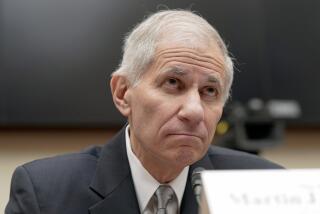The Nightmare That Keeps Bankers Tossing and Turning : Why reform of the federal deposit insurance system is a must
There are growing jitters in the financial community that the Federal Deposit Insurance Corp. could run short of bank insurance funds. That may never happen--most banks are profitable--but the very thought of a shortfall raises fears of yet another horrendous savings-and-loan-type bailout by taxpayers.
In August, the FDIC approved an increase in premiums banks pay to fund depositor insurance. That was a short-term fix. What’s needed is a long-term one. Confidence is crucial to banking. The FDIC is the keeper of the faith.
We advocate some fundamental changes to take the pressure off the FDIC. One change would require banks to be restructured, limiting bank operations to the safest loans and investments. But banks would be allowed to enter new businesses through separate affiliates, which could not use insured deposits and would not be covered by the FDIC.
The FDIC is under stress because more banks are in trouble. The FDIC’s insurance fund is expected to fall to $11 billion this year, the lowest level in its 57-year history. The agency expects to spend about $2 billion on bailouts this year, up from $851 million in 1989. More bank troubles might put the fund dangerously below the $10-billion mark.
Originally, the purpose of the FDIC was to insure small deposits for consumers to prevent bank runs. Instead, it has evolved into a huge safety net for banks themselves. Under its “too big to fail” doctrine, the FDIC typically rescues a failing bank by arranging for its sale. Selling a troubled bank usually is cheaper than liquidating it, and less disruptive for depositors. But the practice results in 100% insurance of banks because deposits, even if they exceed $100,000, are protected with a sale. Thus advocates for deposit insurance reform maintain the FDIC is too protective of banks and depositors.
It’s unlikely that the FDIC can entirely escape the “too big to fail” doctrine. The actual impact of a big U.S. bank failure nationally and worldwide is just too worrisome to contemplate. But the FDIC can and should be spared undue risks by seeking limits on the types of bank activities supported by insured deposits. Raising capital requirements also would hold banks to a higher accountability, which the Federal Reserve Board and FDIC both say is necessary.
Limiting the amount or number of insured accounts is one way to get depositors to take more responsibility for assessing their banks. Reducing the current $100,000 limit is unrealistic. Besides being politically unpalatable, it would put small banks at a competitive disadvantage. But limiting the number of insured deposits--a good idea--that one saver can have is a controversial possibility under study by the Treasury Department.
The FDIC also might revise its premium policy, raising rates and perhaps even keying the premiums according to the risks of individual banks. U.S. banks, for example, do not pay premiums on foreign deposits in their overseas branches. These accounts, however, receive de facto protection because the FDIC typically provides for their transfer in the sale of a failing bank. Big banks save more than $620 million a year by not paying insurance premiums on the $326.7 billion of foreign deposits. This is troubling because the FDIC reports foreign deposits account for about 51% of all deposits at nine of the biggest U.S. banks. This also is an unfair disadvantage for small banks, which rely mainly on domestic deposits.
The FDIC might also develop a clearly defined early warning system that would enable bank regulators to intervene on troubled banks in a more timely fashion--before they are too far gone.
The promise of deregulation of financial services in the 1980s is yielding bitter fruit a decade later. Consumers who were supposed to benefit are the same taxpayers now footing the huge bill for the S&L; mess. They deserve much better. The answer is in Congress--and in careful bank restructuring.
Last of Three Parts
FDIC UNDER SEIGE A look at how the Federal Deposit Insurance Corporation’s bank fund has declined over the past four years: 1987: $18.3 billion 1988: $14 billion 1989: $13.2 billion 1990*: $11 billion * Estimate
Source: FDIC
More to Read
Inside the business of entertainment
The Wide Shot brings you news, analysis and insights on everything from streaming wars to production — and what it all means for the future.
You may occasionally receive promotional content from the Los Angeles Times.










